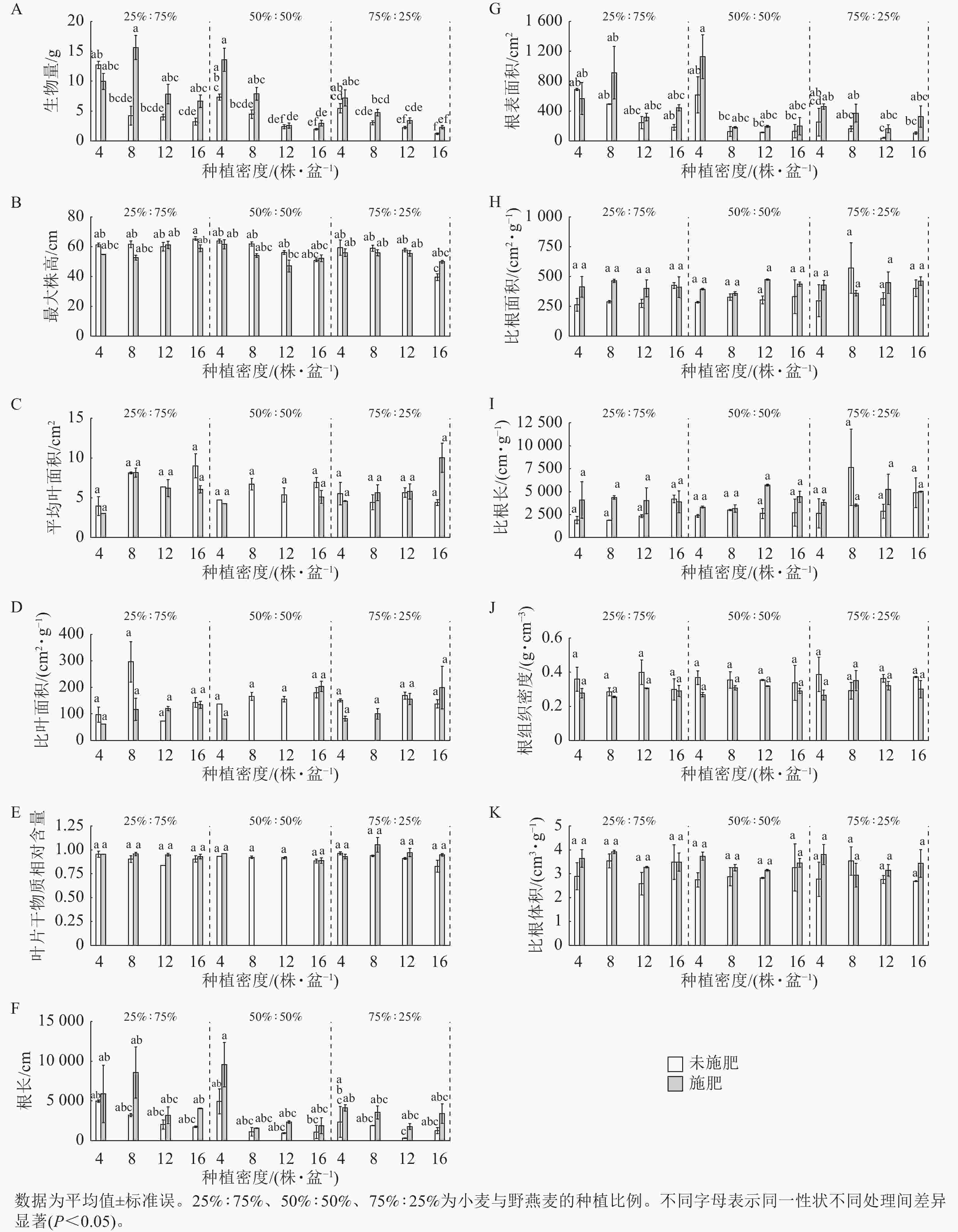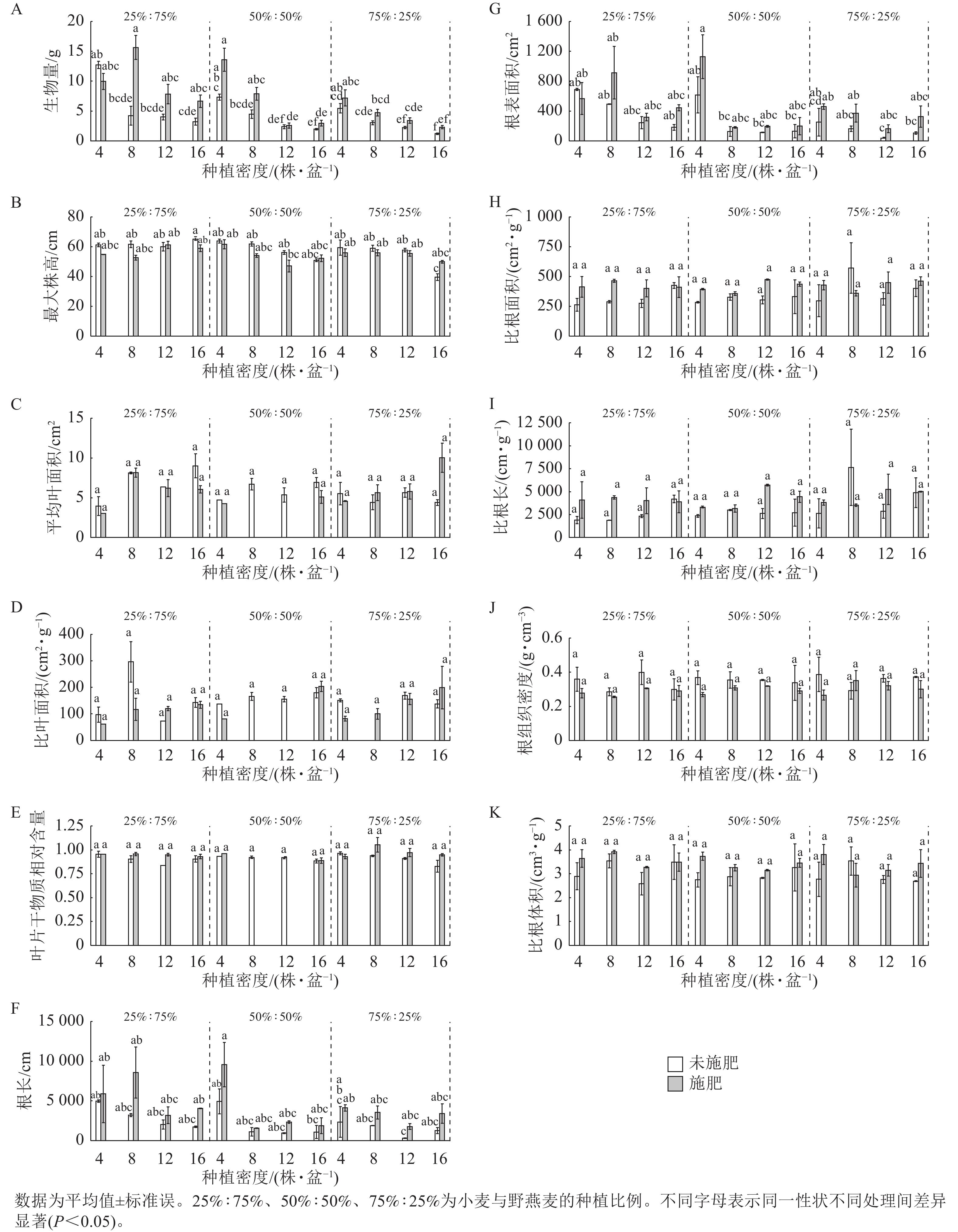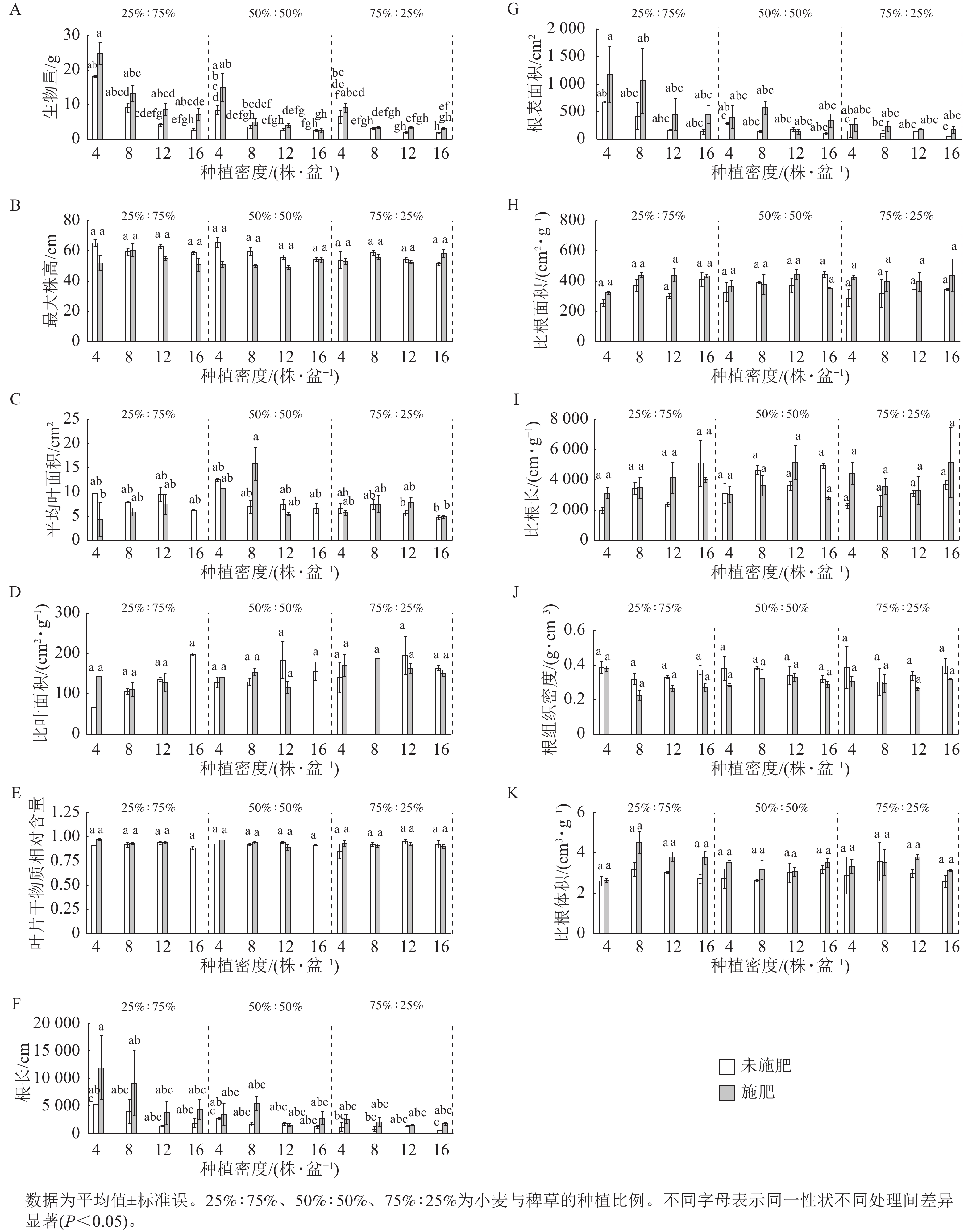-
农田杂草与作物竞争,影响作物生长发育,导致作物产量下降,是农业生产面临的主要危害之一[1]。中国每年的杂草发生面积超过
9000 万hm2,造成的主粮作物损失超过300万t[2]。传统的杂草管理方式,如物理拔除和化学除草剂等,并不能彻底解决农田中的杂草问题,且存在诸多弊端[3]。因此,农作物栽培等领域可以结合生态学理论(如作物-杂草竞争、物种共存等方向)进行学科交叉研究,寻找可持续的综合性杂草管理策略。例如,通过施肥[4]、调控种植密度[5]和杂草种类[6]来调控作物-杂草群落的结构和群落内植物的功能性状,进而影响杂草与作物的资源竞争,从而达到提升作物产量的目的[7−8]。小麦 Triticum aestivum是支撑全球粮食产量的主要作物之一,中国小麦种植面积约2 400万 hm2,占全球总产量的17%[9],麦田杂草主要以禾本科Poaceae植物为主,造成的小麦产量损失每年超过15%,高达150万 t[10]。麦田杂草约200多种,以安徽巢湖农业示范基地小麦田为例,其优势杂草主要为野燕麦Avena fatua和稗草Echinochloa crus-galli,共占杂草总丰度的86%[11]。野燕麦是常见的恶性杂草。稗草原本是水稻Oryza sativa田中的典型杂草[12],偏好温暖阴湿的生长环境,但随着多地区推广稻麦轮作耕作制度,稗草也开始在水分充足的稻茬麦田中出现[11]。
合理的种植密度和施肥是调节作物生长发育的重要栽培措施之一,直接关系到作物的表型和产量[13−14]。适宜的种植密度和施肥可以提高资源利用率,形成优良的农田群落结构[14]。此外,杂草密度和类型也是影响作物产量的主要因素之一[15]。通过改变作物和杂草密度、比例和类型,使群落内出现多种低竞争能力的杂草,进而提升作物产量[7−8]。
植物的功能性状决定了植物对资源的竞争能力[16],是植物适应环境变化的关键生态策略,反映了植物在特定环境中生存和繁衍的能力[17]。其中,株高和叶片性状是光合活动的重要指标[18−19],这些性状不仅与植物的生物量积累和光资源的吸收利用有关,还能够揭示植物的养分供应状态和生存策略[20]。而根系作为植物吸收水分和矿质元素的主要器官,其形态特征与植物吸收利用、生长发育和籽粒产量密切相关。如更高的株高、更大的叶、根面积和体积等,均有助于作物获取光、水、氮等资源并提高利用效率,进而促进生物量的积累[21]。但目前针对小麦-杂草体系中种植密度、比例和施肥对小麦功能性状影响的研究相对较少。因此,本研究以冬小麦为目标作物,研究优势杂草野燕麦和稗草在不同密度和施肥条件下对小麦的生物量和功能性状的影响,旨在为小麦杂草管理和生产提供理论依据。
-
本研究选择在安徽省合肥市庐阳区大杨镇的合肥高新技术农业园内(31°55′28.17″N,117°12′12.85″E)的温室大棚中进行。研究区属于亚热带湿润季风气候,年平均气温为14~22 ℃,全年降水充沛且多集中在夏季,光照充足。供试小麦品种为‘烟农19’‘Yannong 19’,野燕麦和稗草种子采集于合肥高新技术农业园内。挑选均匀饱满、无虫眼和霉坏的小麦、野燕麦和稗草种子,清洗消毒后置于培养皿中,在25 ℃光照培养箱内育苗,待幼苗长至2~4 cm,选取长势基本一致的幼苗移栽进行盆栽试验。
-
冬小麦于2021年11月13日播种,2022年5月开始收割。所用花盆上口直径为24.5 cm,下口直径为18.5 cm,高为25.0 cm。设置3种种植方式(表1):小麦单播(W)、小麦与野燕麦混播(W-O)、小麦与稗草混播(W-B)。氮肥施用量为小麦田常规施肥量(210.000 kg·hm−2),对应每盆施加2.182 g尿素,在移栽前作为基肥溶于水后一次性施入盆栽土壤中[11]。植物栽种参考响应曲面法,在设置密度梯度的同时,嵌套小麦和杂草的种植比例详见表1。盆栽总计128盆,采取随机区组设计摆放,降低光照和温度等环境差异对植株生长的影响。在移栽后的2周内对盆栽中死亡的幼苗进行替补移栽,并去除来自于土壤库中的植株幼苗。
种植方式 种植密度
(株·盆−1)种植比例(小麦∶杂草) 施肥处理 盆数 小麦单播(W) 4、8、12、16 100%∶0 未施肥 16盆(4种种植密度各4盆) 施肥 16盆(4种种植密度各4盆) 小麦-稗草混播(W-B) 4、8、12、16 25%∶75%、50%∶50%、75%∶25% 未施肥 24盆(4种种植密度各6盆,内含3种种植比例各2盆) 施肥 24盆(4种种植密度各6盆,内含3种种植比例各2盆) 小麦-野燕麦混播(W-O) 4、8、12、16 25%∶75%、50%∶50%、75%∶25% 未施肥 24盆(4种种植密度各6盆,内含3种种植比例各2盆) 施肥 24盆(4种种植密度各6盆,内含3种种植比例各2盆) Table 1. Planting pattern for wheat and weeds
-
将植株从土壤中完整采集,分为地上和地下部分,用蒸馏水冲洗干净后置于65 ℃烘箱内48 h至恒量,利用天平(精度
0.0001 g)称取植株生物量。对于地上性状,收样前使用直尺测量植物地上部分的最大拉伸高度,记为最大株高;从每株植物中随机选择不少于总数四分之一的健康完整叶片测量叶片性状,包括叶片鲜质量、叶面积和叶片干质量。叶面积使用Digimizer统计软件测量,叶片质量由天平称量。利用叶面积/叶片干质量计算比叶面积,叶片干质量/叶片鲜质量计算叶片干物质相对含量。对于地下性状,利用根系扫描仪(Expression 12000XL, EPSON) 和WinRHIZO根系分析软件测量植株根长、根表面积和根体积。利用根表面积/根干质量计算比根面积,根长/根干质量计算比根长,根体积/根干质量计算比根体积,根干质量/根体积计算根组织密度。 -
所有数据采用R 4.2.3软件进行分析和绘图。利用ggplot2包绘图[22];将原始数据进行以10为底的对数转化以使数据总体符合正态分布,进而利用stats包对取对数后的数据进行线性回归、方差分析及多重比较,分析种植密度、种植比例、施肥对小麦生物量和功能性状的影响;利用vegan包对原始数据进行冗余分析[23]。
-
在单播小麦条件下,无论是否施肥,随着种植密度增大,小麦生物量显著降低(P<0.05);施肥显著增加了生物量,种植密度为8株·盆−1时增幅最大,达58.8% (图1A,P<0.05)。在功能性状方面,对于地上性状,小麦的最大株高在种植密度为4株·盆−1时最大,施肥对最大株高无显著影响(图1B)。小麦叶面积在未施肥时随着种植密度增大逐渐降低,而施肥显著增加叶面积,且在种植密度为8株·盆−1时增幅最大,达143.4% (图1C,P<0.05)。小麦的比叶面积在种植密度改变时并未发生显著变化,与未施肥相比,种植密度为8株·盆−1时,施肥仅显著增加了比叶面积,从111.90 cm2·g−1增大至168.60 cm2·g−1 (图1D,P<0.05)。小麦叶片干物质相对含量在未施肥时随着种植密度增大呈驼峰形变化趋势,而在施肥情况下随着种植密度增大呈U形的变化趋势(图1E)。对于根性状,施肥和种植密度均未改变根长、根表面积、比根体积和根组织密度(图1F~K)。整体而言,种植密度和施肥会影响单播小麦的生物量和地上性状,而对根性状作用不明显。

Figure 1. Changes of wheat biomass and functional traits with N addition and planting density treatments in monoculture
单株小麦的生物量、最大株高和叶面积之间呈正相关,它们与叶片干物质相对含量呈负相关(图2A);单株小麦的根长与根表面积呈正相关,比根面积和比根长呈正相关,两类根性状呈负相关,比根体积与其余4个性状相关性较小(图2B)。
-
当小麦与野燕麦混播时,无论小麦种植比例如何,随着种植密度增大,小麦生物量显著降低(P<0.05);当种植密度相同时,随着小麦种植比例增大,生物量整体呈下降趋势;当种植密度为8株·盆−1,且小麦与野燕麦种植比例为25%∶75%时,施肥仅显著增加了生物量,未施肥时为4.23 g,施肥时为15.65 g,增加了270.3% (图3A,P<0.05)。在功能性状方面,当小麦与野燕麦种植比例为25%∶75%和50%∶50%时,施肥、种植密度和小麦种植比例均未改变最大株高;当小麦与野燕麦种植比例为75%∶25%时,未施肥时最大株高随种植密度增大显著降低(P<0.05),从密度为4株·盆−1时的最大值(59.41 cm)降低至密度为16株·盆−1时的最小值(39.56 cm);施肥时株高的密度依赖性消失(图3B)。对于叶片性状,施肥、种植密度和小麦种植比例均未改变小麦平均叶面积、比叶面积和叶片干物质相对含量(图3C~E,P>0.05)。对于根性状,施肥、种植密度和种植比例均未改变根长、根表面积、比根长、比根体积和根组织密度(图3F~K,P>0.05)。
-
从图4可见:当小麦与稗草混播时,无论小麦种植比例如何,随着种植密度增大,小麦生物量显著降低(P<0.05);当种植密度相同时,随着小麦种植比例增大,生物量整体呈下降趋势;施肥并未改变小麦生物量。在功能性状方面,施肥、种植密度和种植比例均未改变小麦地上性状和根性状。施肥、种植密度和种植比例的交互作用会改变根长和根表面积。在未施肥时,当种植密度为4株·盆−1,且小麦与稗草种植比例为25%∶75%时,小麦根长和根表面积最大,而当种植密度为16株·盆−1,且小麦与杂草种植比例为75%∶25%时,小麦根长和根表面积最小。
-
本研究中,无论是单播还是混播,小麦的单株生物量随着种植密度的增大而显著下降,不依赖于小麦邻体杂草的物种类型。这与以往的研究结果一致,这是因为在高种植密度下,个体可用资源减少[24]。当小麦与野燕麦混播种植比例为75%∶25%,且未施肥时,小麦的最大株高随种植密度增大而显著降低,而此时小麦与稗草混播中的小麦最大株高无明显变化。这表明在相同种植密度和种植比例下,小麦与野燕麦共存时承受着更为激烈的光竞争压力。这可能是因为冬季和早春气温较低,导致原本在温暖潮湿地区常见的稗草发芽和生长较慢[25−26]。相比之下,野燕麦耐旱耐冷、适应性强,拔节后生长迅速,能对小麦构成更大的竞争。此外,野燕麦种子成熟时间较早,这也增大了其对土壤资源的占据[27],体现了杂草生长过程中的权衡策略[28],即通过缩短生育期来获取在资源竞争中的优势[29]。
-
施肥是提高土壤肥力的常用手段[30−31]。本研究发现:在小麦单播时,施肥可以增大单株小麦的生物量和叶面积,表明施肥能通过缓解氮受限来增强光合作用和呼吸作用,从而促进生物量的积累[32]。然而,在混播系统中,施肥与否对小麦的生长并无显著改变,这可能是因为当前施肥量对小麦生长的增益不足以弥补种植密度对小麦生长的制约[32],也可能是因为邻体杂草的竞争作用抵消了施肥对小麦生长的促进[33]。
-
当小麦与野燕麦混播时,施肥显著增加了种植密度为8株·盆−1,种植比例为25%∶75%时的单株小麦生物量。这可能是因为施肥后土壤中的可利用氮素增加,在一定程度上缓解了对小麦株高和根系生长的密度制约效应,从而有利于小麦生物量的积累。同时,土壤中可利用氮素的增加也会促进杂草的生长[34],而野燕麦的生长能力和养分吸收能力优于小麦[35],因此施肥处理可能会加剧野燕麦对小麦产量的密度制约效应。而当小麦与稗草混播时,施肥对其影响相对较小。这表明种植密度、种植比例和施肥的交互作用对小麦与杂草混播时单株小麦生长的影响可能具有杂草依赖性。种植密度和施肥的交互作用对根长和根表面积的影响较大,即在低密度施肥时最高而高密度未施肥时最低,而对株高和叶片性状的影响较小。这可能是因为与大田环境相比,盆栽不同植株获得光资源的差异较小,而土壤资源和空间受限,使得小麦根系需要发生比地上性状更大的表型可塑性以获取养分和生长。
本研究采用容易获得的形态性状进行分析,并未对叶片光合作用、根呼吸和根系分泌物特征等生理性状进行研究,这些性状能更准确地反映植物对不同环境因子的响应[36],但难以快速大量测量[37−38],所以相关研究仍然较少。为了能进一步揭示植物地上、地下性状的权衡机制并将其运用到农业生产和杂草管理之中,应在不同作物、不同耕作方式和不同的田间配置条件下进行有关植物生理属性的研究,并平衡多个功能性状间的权衡关系提高作物适合度。
-
种植密度、种植比例和施肥的交互作用对小麦与杂草混播系统中小麦的生物量、根长和根表面积产生较大影响,而对株高和叶片性状的影响相对较小。在相同的种植条件下,野燕麦对小麦生长的不利影响超过稗草。施肥则根据混播的杂草种类而表现出不同的效果。因此,在农业生产实践中,应合理调控种植密度、杂草比例和施肥量。同时,在进行杂草管理时应选择合适的杂草种类,以发挥作物和杂草多样性在调控产量中的潜在价值。
Effect of dominant weeds on wheat growth characteristics under different planting densities and fertilization treatments
doi: 10.11833/j.issn.2095-0756.20240193
- Received Date: 2024-02-28
- Accepted Date: 2024-08-17
- Rev Recd Date: 2024-07-10
- Available Online: 2024-11-20
- Publish Date: 2024-11-20
-
Key words:
- crop-weed competition /
- species coexistence theory /
- weed management /
- trait
Abstract:
| Citation: | RONG Yizhong, GAO Junjie, CHENG Shushi, et al. Effect of dominant weeds on wheat growth characteristics under different planting densities and fertilization treatments[J]. Journal of Zhejiang A&F University, 2024, 41(6): 1252-1260. DOI: 10.11833/j.issn.2095-0756.20240193 |













 DownLoad:
DownLoad:


